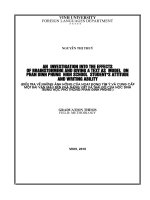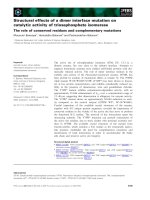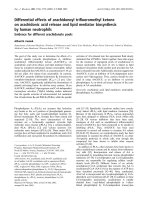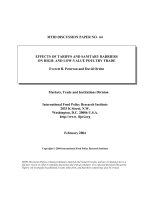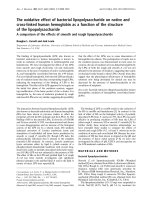EFFECTS OF TARIFFS AND SANITARY BARRIERS ON HIGH- AND LOW-VALUE POULTRY TRADE potx
Bạn đang xem bản rút gọn của tài liệu. Xem và tải ngay bản đầy đủ của tài liệu tại đây (241.46 KB, 49 trang )
MTID DISCUSSION PAPER NO. 64
Markets, Trade and Institutions Division
International Food Policy Research Institute
2033 K Street, N.W.
Washington, D.C. 20006 U.S.A.
http://www. ifpri.org
February 2004
Copyright © 2004 International Food Policy Research Institute
MTID Discussion Papers contain preliminary material and research results, and are circulated prior to a
full peer review in order to stimulate discussion and critical comment. It is expected that most Discussion
Papers will eventually be published in some other form, and that their content may also be revised.
EFFECTS OF TARIFFS AND SANITARY BARRIERS
ON HIGH- AND LOW-VALUE POULTRY TRADE
Everett B. Peterson and David Orden
i
ACKNOWLEDGEMENT
We thank Donna Roberts, ERS/USDA, Timothy Josling, Stanford University, and
Mark Gehlhar, ERS/USDA, for comments and early contributions to this research. We
also thank ERS/USDA and the European Commission for financial support of this
research through a cooperative agreement with Virginia Tech and grant to IFPRI,
respectively.
ii
ABSTRACT
A competitive partial-equilibrium spatial model with heterogeneous goods is constructed
to evaluate effects of the removal of tariffs, tariff-rate quotas, and sanitary regulations on
world poultry trade. The model distinguishes between “high-value” (mostly white meat)
and “low-value” (mostly dark meat) poultry products and simulates the trade flows
between eight exporting and importing countries and regions. Removing all barriers
simultaneously has larger impact on trade than only removing tariffs and tariff-rate
quotas. Imposition of sanitary barriers against US products by Russia shifts trade flows,
but does not have large net impacts on US producers.
iii
TABLE OF CONTENTS
1. INTRODUCTION ………………… 1
2. MODEL…………………………… 3
Poultry Sector 3
Consumer Demand 6
Government Policies 8
Data 10
Calibration 14
Remaining Demand Parameters 18
Supply Response 21
3. RESULTS …………………………. 21
Removal of Tariffs and TRQs 22
Long-run Supply Elasticities 22
Entry of Brazil into New Markets 27
Short-run Supply Elasticities 28
Sensitivity Analysis 29
Removal of SPS Barriers 30
Free Trade 30
Russian Ban on US Low-Value Poultry Imports 31
4. SUMMARY AND CONCLUSIONS ………………. 35
REFERENCES ………………………… 37
iv
LIST OF TABLES
Table 1—Unit Value of 1998 World Poultry Trade, SITC Code 01235, US Dollars per
Metric Ton 8
Table 2—Summary of Tariffs Rates Imposed by Non-Composite Regions 9
Table 3—Bilateral SPS Barriers to Poultry Trade 9
Table 4—Benchmark Data 12
Table 5—Transportation Costs 14
Table 6—Demand Elasticities at Initial Prices 20
Table 7—Model Results 33
LIST OF FIGURE
Figure 1—Structure of Consumer Preferences 7
1
EFFECTS OF TARIFFS AND SANITARY BARRIERS ON
HIGH-AND LOW-VALUE POULTRY TRADE
Everett B. Peterson
1
and David Orden
2
1. INTRODUCTION
World poultry markets are one of the most rapidly growing sectors of the food
industry. Poultry production rose six-fold between 1965 and 2002 to over 70 million tons.
Consumption increases have exceeded population growth, with world per capita supplies
of poultry meat tripling from 3.3 kg to more than 10 kg. International trade has more
than kept pace with this industry growth. World exports of poultry meat rose from
375,000 tons in 1965 to over 6.5 million tons in 2002. Thus, trade now accounts for
about 10% of world consumption.
The objective of this paper is to evaluate the effects of sanitary barriers to poultry
trade in the context of the economic incentives and other trade policy decisions that
determine product flows in international poultry markets. Poultry flocks are susceptible
to diseases that can spread domestically and across borders. Microbial contamination of
poultry for human consumption is also a serious problem in the sector, as with other
meats, and is addressed by health regulations in exporting and importing countries. Thus,
poultry markets are subject to a complex mix of national and trade sanitary regulations,
1
Everett Peterson is Associate Professor, Department of Agricultural and Applied Economics, Virginia
Tech, Blacksburg, Virginia 24061, USA.
2
David Orden is Senior Research Fellow, Markets, Trade and Institutions Division, International Food
Policy Research Institute (IFPRI), Washington D.C.
2
together with non-technical barriers in the form of tariffs and tariff-rate quotas (TRQs).
The 1995 World Trade Organization Agreement on Agriculture and on the Application of
Sanitary and Phytosanitary (SPS) Measures have, to some extent, affected this mix,
reducing levels of non-technical border protection, while tightening the rules for sanitary
measures.
To evaluate the policy effects on world poultry trade, a perfectly competitive,
spatial partial-equilibrium model with heterogeneous goods is constructed to simulate the
trade flows between six key non-composite exporting or importing regions (five countries
and the European Union (EU)) and two rest-of-world region aggregates. The model
incorporates several extensions of previous work. First, most previous analysis of the
economic effects of technical barriers has examined bans on product shipments across a
single border (Calvin and Krissoff; Paarlberg and Lee). Since alternative trade
opportunities have not been evaluated in these case studies, assessment is precluded of
arbitrage occurring through trade “deflection” when a bilateral ban leads other exporting
countries to increase their sales to the specific importing region, with the “banned” sales
going elsewhere in world markets. As will be seen, there is a complex non-transitive set
of existing bilateral poultry sanitary barriers between regions, indicating that trade
deflection plays an important role in global poultry markets.
The second extension of previous work in our model is the separate identification
of high-value (mostly white meat) and low-value (mostly dark meat) poultry products.
Earlier poultry models have aggregated all products into a single category (Alston and
Scobie; Kapombe and Colyer; Koo and Golz; Wang, Fuller, Hayes and Halbrendt). Yet,
3
bilateral trade data indicate that most often a country’s imports and exports are
concentrated in either high-value or low-value products. Maintaining this distinction
significantly affects the benchmark model and simulated results of removing non-
technical and sanitary trade barriers. Orden, Josling and Roberts provide a simplified
model with products differentiated by high and low value but assumed to be
homogeneous between regions within each market category.
2. MODEL
A heterogeneous good, spatial partial-equilibrium model with perfect competition
affected by non-technical and sanitary trade barriers is used to represent the global
poultry sector. There are eight regions in the model: United States (US), Brazil, the EU,
Japan, China, Russia, a rest-of-world poultry exporting region (ROWE), and a rest-of-
world poultry importing region (ROWM). The non-composite regions were chosen
because they account for a significant portion of world poultry production (approximately
70%) and poultry trade (approximately 90% of all exports and 75% of all imports).
POULTRY SECTOR
All production, processing, and distribution activities within each region are
aggregated into one industry. This level of aggregation is a simplifying assumption and
reflects that for some regions, such as the United States, the production and processing
activities are vertically integrated. A positive linear relationship is assumed between an
aggregate poultry price and aggregate poultry production.
4
A wide range of poultry products are traded and are aggregated in the model into
two distinct categories: high-value and low-value products. The high-value poultry
product includes white meat (breasts and wings) of chicken and turkey along with de-
boned meat and specialty items. Low-value poultry is comprised of mainly dark meat
(drumsticks and thighs) of chicken and turkey.
3
White and dark meats are produced in
essentially equal and fixed amounts per bird and are thus treated as jointly produced
goods in the model. The distinction among trade flows in high-value and low-value
products is a reflection that most countries mainly import (or export) dark (or white) meat
due to the preferences of domestic consumers relative to production. For example, China
and Russia import low-value poultry products, the EU imports high-value poultry
products, and the US, and also the EU, export low-value products. Brazil, in contrast,
exports both high- and low-value poultry parts.
Because of the assumption of joint production, the supply responsiveness of the
poultry sector depends on an aggregate poultry price, which is an average of the high-
value and low-value poultry prices. Joint production links the high-and low-value
supplies and thus affects the simultaneous price determination in both markets. For
example, an increase in the high-value poultry price will encourage more high-poultry
products to be produced. However, to produce more high-value poultry also entails the
production of more low-value poultry products. If the demand for low-value poultry
remains constant, then an increase in low-value poultry production would lead to a
3
The distinction between white and dark meat product categories is consistent with industry
characterizations of the poultry market. See Fuller.
5
reduction in the price of low-value poultry. This low-value price reduction would offset
some or possibly all of the high-value price increase, reducing the incentive to expand
poultry production.
Formally, the relationship between the high-value and low-value poultry prices
and the poultry supply response can be seen using the definition of the aggregate poultry
price:
(1) 0.5 0.5
AHL
PPP
=
+ ,
where
A
P is the aggregate poultry price,
H
P is the high-value poultry price and
L
P is the
low-value poultry price. Totally differentiating equation (1) and converting the
differentials to percentage changes yields:
0.5 0.5
ˆˆˆ
HL
AHL
AA
PP
PPP
PP
=+
.
Multiplying each term on the right-hand side by
AA
qq, where
A
q is quantity of
aggregate poultry production and noting that 0.5
H
LA
qq q
=
= :
(2)
0.5 0.5
ˆˆˆˆˆˆˆ
AH AL H H LL
AHLHLHHLL
AA AA AA AA
qP qP qP qP
PPPPPrPrP
Pq Pq Pq Pq
=+=+=+
,
where
H
r and
L
r are the revenue shares of high-value and low-value poultry products.
The percentage change in the aggregate poultry price is a revenue share weighted average
of the percentage changes in the individual poultry prices. Any combination of changes
in high-value and low-value poultry prices that increase the aggregate poultry price will
lead to an increase in both high-value and low-value poultry output.
6
CONSUMER DEMAND
Consumer demand for poultry products in each region is represented by a four-
level nested Constant Elasticity of Substitution (CES) demand system (see figure 1). At
the bottom level, consumers choose among alternative sources of imported high-value
poultry products or low-value poultry products, respectively. We have chosen to use an
Armington specification due to the variation in unit value across exporters for a given
importing region (see table 1). This price variation indicates there are some differences
across countries in the specific types of high- or low-value products being traded. Thus,
the low-value poultry being exported from the US is not exactly the same products as the
low-value poultry from the EU or Brazil.
In the second-level of the nested CES demand system, consumers choose between
a domestically produced and an aggregate imported high-value or low-value poultry
product. So if imports become more expensive relative to domestically produced poultry,
consumers will substitute away from imports. At the third-level, consumers choose
between aggregate high-value and low-value poultry products. If the aggregate price of
high-value poultry, which is a function of the price of imports and the domestic price of
high-value poultry, increases relative to the aggregate price of low-value poultry,
consumers will increase their consumption of low-value poultry and decrease their
consumption of high-value poultry. At the top-level of the demand system, consumers
choose between an aggregate poultry product and all other products. This allows for
consumers to increase or decrease their overall consumption of poultry products as the
aggregate relative price of poultry changes.
7
Figure 1—Structure of Consumer Preferences
Total Utility
All Else
Poultry
High-Value Low-Value
Domestic Imported Domestic Imported
Country 1 Country n
Country 1
….
Country n
3
σ
4
σ
2
σ
3
σ
1
σ
4
σ
8
Table 1—Unit Value of 1998 World Poultry Trade, SITC Code 01235, US Dollars
per Metric Ton
Importers
All Others
Exporters US Brazil EU China Japan Russia High-Value Low-Value
US 647 1112 719 808
Brazil 2505 717 1940 1774
EU 936 712 710
China 1890 1563
All Others
High-Value 3264 2060
Low-Value 798 885
Source: International Bilateral Agricultural Trade Database, Economic Research Service, USDA,
developed from the United Nations Conference on Trade and Development bilateral SITC trade
data.
Note: The trade data contained several instances of very small trade flows, generally less than 500 metric
tons between regions in the model. Because of their small magnitudes and likelihood that they
represent trade in specialty poultry products, these trade flows are dropped from the benchmark
trade flows.
GOVERNMENT POLICIES
The base year of the model is 1998. During that year, all non-composite regions
imposed tariffs on imported poultry products. Table 2 summarizes the tariff levels
imposed by these regions. The Japanese import market has the lowest tariffs of all of the
non-composite regions. This in part reflects the Japanese government’s encouragement
of foreign investment by Japanese poultry firms in Brazil, Thailand, and China. The EU
restricts poultry imports through TRQs, which are allocated to Brazil, Canada, Mexico,
and countries in Central and Eastern Europe that have quota-restricted preferential access
under the Europe Agreements, and imposes prohibitive over-quota tariffs. Both the US
and Brazil use tariffs to protect their poultry markets even though they are relatively low-
cost exporters.
Because poultry flocks are susceptible to infectious diseases and microbial
contamination of poultry meat is a serious problem, many countries have sanitary
9
regulations that impose restrictions on exports from one or several countries. Table 3
summarizes whether there are binding sanitary (SPS) barriers between the six non-
composite regions in the model.
Table 2—Summary of Tariffs Rates Imposed by Non-Composite Regions
Region Tariff Rates Average Rate
US Tariffs bound at $0.088/kg for whole chicken and $0.176/kg for parts (18-
36 % ad valorem).
25%
Brazil Tariffs bound in the WTO at 35 % on all poultry products. 35%
China Tariffs of 45 % on all poultry products. 45%
EU Tariff of 299 ECU/mt. on whole chicken and 358 ECU/mt. on parts (18-
60 % ad valorem). Tariff-rate quotas established with quantities allocated
to Brazil and Central and Eastern European countries.
20%
Japan Tariffs of 11.9 % on whole chicken and 8.5 % on parts. 10%
Russia Tariffs of 30 % on chicken and 15 % on turkey. Trade agreement with
EU gives no special access to European imports. Restrictions on
transshipments through Baltic countries.
22.5%
Source: USITC, USDA, and WTO Schedules
Table 3—Bilateral SPS Barriers to Poultry Trade
Importers
Exporters US Brazil EU China Japan Russia
US Banned Banned Allowed Allowed Allowed
Brazil Banned Allowed Allowed Allowed Allowed
EU Allowed Allowed Allowed Allowed Allowed
China Banned Banned Banned Allowed Allowed
Source: Authors’ review of trade-related regulations.
10
One might expect that these regions would divide into two groups, those free of
highly-infectious poultry diseases and those that are not free of disease, with trade
occurring within each group. However, this is not the case. The major importers of
poultry products, China, Japan, and Russia, accept imports from all exporting regions in
the model. The two major exporters, the US and Brazil, do not accept imports from each
other and also ban imports from China, based on recurrent outbreaks of Newcastle
Disease. The EU also bans imports from the US and from China. The main point of
disagreement between the US and the EU is on the use of end-of-line chlorine
decontamination in US processing facilities. The EU does not consider this to be
equivalent to trisodiummonophosphate or lactic acid decontamination, and therefore has
banned poultry imports from the US. Imports of poultry from Brazil into the US are
banned based on intermittent outbreaks of poultry diseases in Brazil. The EU does not
block imports from Brazil due to disease problems. Finally, Brazil’s SPS barrier against
imports from the US is based on the decision that the inspection system for poultry
processing plants in the US is not equivalent to its own. Thus, diverse sanitary barriers
applied differently among countries lead to a complex set of trade opportunities.
DATA
The benchmark bilateral trade flows are obtained from the USDA International
Bilateral Agricultural Trade Database that is adopted from trade data of the United
Nations and contains information on the quantity, in metric tons, and the value of poultry
trade in each category
4
. The UN trade data distinguishes six, five-digit SITC categories
4
Access to the trade data was provided by Mark Gehlhar, ERS/USDA.
11
for trade in poultry products. These SITC categories separate poultry into whole birds,
cuts, and livers, as well as between fresh or chilled and frozen. The dominant SITC
category is 01235, “Poultry cuts and offal (other than livers) frozen,” which accounts for
nearly 70% of world (excluding intra-EU) poultry trade. Because of our interest in
differentiating the distinct markets for high-value and low-value poultry products, we
focus our analysis on these frozen poultry cuts. The next largest category is SITC 01232,
“Poultry not cut in pieces, frozen,” which accounts for approximately 20% of world
poultry trade. We exclude this and the other four categories to retain tractability in our
differentiated-product model.
The bilateral trade flows within the category of frozen poultry cuts were assigned
to either high-value or low-value products based on the unit values computed from the
data (see table 1). For example, Brazilian exports to Japan and the EU (with unit values
of $1940 and $2505, respectively) are assumed to consist of high-value poultry products,
while Brazilian and US exports to China, or US exports to Russia (with unit values of
$717, $647 and $719, respectively) are assumed to consist of low-value poultry products.
Table 4 shows quantities of the benchmark bilateral trade flows in high-value and low-
value products on this basis. The only gray area in this dichotomy is US exports to Japan,
whose unit value does not appear to fit in either category. In examining the US trade data
at the 10-digit HS level, approximately 70 percent of US exports to Japan are in the
category “0207140090” which is defined as “frozen other cuts/edible offal (inc livers).”
12
Table 4—Benchmark Data
Domestic Consumption (+), Exports (+), or Imports (-)
Country Production Price
US Brazil ROWE EU China Japan Russia ROWM
Net
Trade
High-Value (Million MT) $/MT (Million MT)
US 7.619 1950 7.619 0.000
Brazil 2.485 1850 2.328 0.043 0.067 0.047 0.157
ROWE 2.841 1800 2.654 0.062 0.125 0.187
EU 4.446 2900 -0.043 -0.062 4.552 -0.105
China 5.675 1750 5.428 0.194 0.054 0.247
Japan 0.606 2200 -0.067 -0.125 -0.194 0.991 -0.385
Russia 0.345 2205 0.345 0.000
ROWM 7.206 2000 -0.047 -0.054 7.306 -0.101
Total HV 31.222
Low-Value
US 7.619 485 5.581 0.491 0.076 0.683 0.789 2.038
Brazil 2.485 545 2.349 0.136 0.136
ROWE 2.841 600 2.715 0.126 0.126
EU 4.446 600 3.871 0.139 0.145 0.292 0.576
China 5.675 1100 -0.491 -0.136 -0.126 -0.139 6.565 -0.891
Japan 0.606 750 -0.076 0.682 -0.076
Russia 0.345 925 -0.683 -0.145 1.172 -0.827
ROWM 7.206 800 -0.789 -0.292 8.287 -1.081
Total LV 31.222
Total 62.444
Sources: Production from FAOSTAT; trade flows from International Bilateral Agricultural Trade Database, Economic Research Service, USDA,
developed from the United Nations Conference on Trade and Development bilateral SITC trade data; domestic prices derived from model
calibration by the authors.
13
Because nearly all of US exports to China and Russia also fall in the same category, and
to avoid creating a second low-value products classification in the model, we assume that
US exports to Japan are low-value products.
5
Given the relatively small amount of US
poultry exports to Japan (76,100 metric tons), this abstraction should not substantially
affect the model results.
The level of poultry production for each region is given in the first column of
table 4. It is the 1998 estimate of poultry meat production (obtained from the Food and
Agriculture Organization FAOSTAT database). The level of poultry production in the
two composite regions is determined by first identifying which countries are net poultry
exporters in FAO trade data. Then, the level of poultry production in the ROWE region
is the sum of production in these exporting countries. Poultry production for the ROWM
region is obtained by subtracting the quantity of poultry meat produced in China, the EU,
Brazil, Japan, Russia, the US, and the ROWE region from world poultry production.
Data on domestic prices of high and low-value poultry products by region were
not available. The general magnitude of these prices can be inferred from the reported
unit trade values and estimated transportation costs shown in table 5. Exact domestic
prices for each region for the base case scenario were determined as part of the model
calibration process.
5
When comparing the unit export values within the 10-digit HS category between Japan, China, and
Russia, the unit export value to Japan were approximately 50% higher, indicating that even within this
narrow HS category there are product or quality differences.
14
Table 5—Transportation Costs
US Brazil EU China Japan Russia ROWE ROWM
Dollars per mt.
US 190 180 222 205 212 250 275
Brazil 190 190 260 252 200 250 211
EU 180 190 203 235 214 250 239
China 222 260 203 139 240 211 285
Japan 205 252 235 139 235 174 250
Russia 212 200 214 240 235 250 250
ROWE 250 250 250 211 174 250 350
ROWM 275 211 239 285 250 250 350
Source: Author’s estimates from limited available ocean freight rates.
CALIBRATION
The calibration process for the CES demand system begins at high- and low-value
import sub-utility functions because it is the level where both initial quantities and
expenditure are observed. The CES utility and sub-utility functions, for each region i, for
each level of the demand system in figure 1 can be expressed as:
(3)
1
1
1
11
,1,
nn
jj j
jj
Ux
σ
σ
σ
σ
σ
αα
−
−
==
⎧⎫
=
=
⎨⎬
⎩⎭
∑∑
where
j
α
is a shift parameter to be determined during calibration,
j
x
is the quantity of
good j consumed, n is the number of goods consumed,
σ
is the elasticity of substitution
for that level in the nested CES demand structure, and the regional subscript i is
suppressed for simplicity. The resulting demand function and true cost-of-living price
index for each level are then:
(4)
1
jj
j
jj
j
p
I
x
p
σ
σ
α
α
−
−
=
∑
and
15
(5)
1
1
1
1
n
Mjj
j
Pp
σ
σ
α
−
−
=
⎧
⎫
=
⎨
⎬
⎩⎭
∑
,
where
I is total or group expenditures,
j
p
is the price of good j, and
M
P
is the price index.
Typically, equation (4) is calibrated by rescaling all prices to equal one and
setting the values of
j
α
equal to the associated import share of that good from region j
into region
i. A problem with this approach is that if region j does not export to region i
in the initial equilibrium,
j
α
is set equal to zero which then bars the possibility of region
j from exporting to region i after reform of trade policies occurs. Because removing trade
barriers could alter the observed pattern of trade, this method of calibrating the
j
α
is
clearly constraining. By assuming instead that all
j
α
α
=
for those countries exporting to
a given region in a given scenario, then
j
α
can be eliminated from equations (4) and (5).
6
The implication of assuming all
j
α
α
=
is that imports from each region with which trade
is considered feasible are consumed in equal amounts if all import prices are the same. A
limitation of the assumption that all
j
α
’s are assumed to be equal is that the calibrated
prices can not be made to exactly match the data-derived export unit values for all
regions. This is because the differences in relative import quantities are strictly due to
relative price differences, whereas choice of unique
j
α
’s for each exporting region
reflects other demand factors affecting relative import levels.
6
This is due to the ordinal properties of all utility functions. If all
α
’s are equal in equation (2), then a
monotonic transformation will allow them to be removed without altering the preference structure of the
utility function.
16
Using equation (4) under our assumption on the
j
α
’s, the prices of imported
high-value or low-value poultry products are determined to replicate the benchmark trade
flows and total expenditures on imports by each region. The values of the calibrated
import prices are also a function of the value of the elasticity of substitution between
import sources (
4
σ
in figure 1). The smaller the value of this elasticity, the larger will be
the calibrated import price differentials between regions. Various values for the import
elasticity of substitution were tried during the calibration process. Values of less than 10
resulted in much larger price differentials than the differentials in unit export values
while values over 10 did not reduce the price differentials substantially. Therefore, the
elasticity of substitution between imports is assumed equal to 10 for all regions.
7
To illustrate the price calibration process, consider the imports of high-value
poultry into Japan. In the benchmark, three regions, Brazil, China, and the ROWE export
385,100 mt. of high-value poultry to Japan at a value of $752.4 million. A system of
three equations, representing the quantity of high-value poultry imported from each
region, in three unknowns, the import prices, is then solved.
8
The resulting import prices
are tariff inclusive c.i.f. prices. Continuing with the Japan example, the calibrated high-
value import prices per mt. for the base model scenario are $2,312 for Brazil, $2,078 for
China, and $2,172 for ROWE. Corresponding base case domestic poultry prices were
calculated from these results. Dividing the calibrated import price by the one plus the
tariff rate and then subtracting the transportation costs given in table 5 determines the
7
Alston and Scobie considered two different values for this parameter, 3 and 36, in their analysis. We use
a value of 5.0 in conducting a sensitivity analysis of our results.
8
The system of nonlinear equations is solved using the CNS solver in GAMS.
17
domestic price for each of the exporting countries, as shown in table 4.
9
The domestic
price of high-value poultry in Japan is estimated to approximately equal the average
import price.
For low-value poultry, the domestic price for the US and the EU are averages of
the calibrated tariff-inclusive c.i.f. prices for China and Russia adjusted for the tariffs and
less transport cost (ROWM is excluded from the averages because transportation costs
are not known). For Brazil, the domestic low-value price is based on the calibrated c.i.f.
price for China. For China, Russia, and ROWM, the domestic low-value poultry price is
set equal to the average tariff-inclusive c.i.f. import price in each region. For Japan, the
import price and domestic price of low-value poultry are set at the domestic US price
plus transportation costs and tariffs.
While the domestic prices for most high-value and low-value product can be
determined from the calibrated import prices, tariffs, and estimated transport costs,
alternative methods must be used for regions that do not export or import a given poultry
product. For the US, the high-value poultry price is set equal to an average wholesale
price of chicken breast, chicken wings, and turkey breast (USDA, AMS). For Russia, the
domestic high-value price is set equal to the average domestic high-value price in Brazil,
China, and ROWE times the 22.5 percent tariff rate. Thus, the domestic high-value price
in Russia would be less than the domestic price of the potential exporters plus transport
cost. This assumption is made because Russia does not import any high-value poultry
and a domestic price less than the exporter’s price plus transport cost would discourage
9
The transportation costs were adjusted slightly in order to round the poultry prices to the nearest $5/mt.
18
high-value exports to Russia. Finally, because of the TRQ in the EU, the calibrated high-
value import prices are not considered accurate reflections of the EU domestic prices. In
1998, the average wholesale price for young chickens was approximately $1,750 per
metric ton (European Commission). Thus, the EU high-value poultry price was
computed such that the simple average of the domestic high-value and low-value price
equals $1,750.
Remaining Demand Parameters
Once domestic prices for all products have been calculated, the parameters in the
remaining CES utility and sub-utility functions can also be determined. Since all the
remaining groups in the nested CES have only two goods, equation (4) is modified to:
(6)
()
()
()
11
1
j
j
jm
pI
x
pp
σ
σ
σ
α
αα
−
−−
=
+−
.
For example, consider the sub-utility functions that govern the substitution between
domestic and import high-value (low-value) poultry products. Then
j
x
is the quantity of
the domestic poultry product consumed,
j
p
is the domestic price,
m
p
is the import price
index, determined using equation (5),
σ
is the elasticity of substitution between domestic
and imported products (i.e., the Armington elasticity or
3
σ
in figure 1), and I is
expenditure on high-value (low-value) poultry products. Once an elasticity of
substitution is chosen, the only unknown parameter that needs to be chosen is the shift
parameter
α
.
19
Values for
13
and
σ
σ
in each region are obtained from the Global Trade Analysis
Project (GTAP) database. The elasticity of substitution between poultry and all else (
1
σ
)
is set equal to the Allen partial elasticity of substitution between the GTAP commodity
“other meat products” (which includes poultry meat) and an all other commodity
aggregate for each region (see table 6). Given that the budget share for all poultry
products is small, the value of
1
σ
basically determines the aggregate own-price demand
elasticity for poultry.
10
The Armington elasticities in the GTAP database vary across
products, but not across regions. We use a value of 2.5, which is an average between the
two GTAP commodities that include live and processed poultry products.
No estimates of the elasticity of substitution between high-value and low-value
poultry products (
2
σ
) were available. Because of the strong consumer preferences for
either white or dark meats in various regions, such as the preference for white meat
versus dark meat in the US and the converse in Brazil and Russia, it is assumed that
substitution possibilities in demand between high-value and low-value products is
limited. Therefore, we assumed an elasticity value of 0.5 for all regions. Based on the
assumed values of the elasticities of substitution and the initial consumption budget
shares, all poultry products are gross substitutes for one another in all regions.
The implied own-price uncompensated demand elasticities for high-value and
low-value poultry for all regions are given in table 6. In general, the demand elasticities
10
The aggregate demand elasticity for poultry is equal to
(
)
11
1
A
s
σ
σ
−
−
, where s
A
is the budget share
for all poultry products.
20
for domestically produced products are inelastic while the elasticities for imports are
elastic. This difference is due to much smaller consumption shares for imports. The
relatively larger demand elasticities in Japan are due to smaller poultry consumption
shares. These demand elasticities are within the ranges used by previous studies
.
11
Table 6—Demand Elasticities at Initial Prices
Own-Price Demand Elasticity
c
Region
1
σ
a
DHV
b
IHV DLV ILV
US 0.30 -0.33 -0.47
Brazil 0.20 -0.27 -0.43
ROWE 0.15 -0.24 -0.41
EU 0.20 -0.30 -2.45 -0.46
China 0.25 -0.36 -0.60 -2.30
Japan 0.40 -1.17 -1.75 -0.80 -2.18
Russia 0.10 -0.32 -1.72 -1.06
ROWM 0.20 -0.32 -2.47 -0.68 -2.23
a
Elasticity of substitution between poultry products and all other products in consumers’ utility
function in figure 1. The other elasticities of substitution in figure 1 do not vary across countries.
The assumed values of
2
σ
,
3
σ
, and
4
σ
are 0.5, 2.5 and 10 respectively.
b
The abbreviations DHV, IHV, DLV, and ILV stand for domestic high-value poultry products,
imported high-value poultry products, domestic low-value poultry products, and imported low-
value poultry products. Cells without an entry represent zero consumption in the benchmark data
set.
c
The unconditional own-price elasticities for a nested CES utility function are derived based on the
formula from Keller for the own-price Allen partial elasticities of substitution. For example, the
own-price Allen partial elasticity of substitution for domestic high-value poultry products is:
()
(
)
(
)
11 11 1
321
1
p
DHV DHV HV HV P
cc cc c
σσ σ σ
−− −− −
⎡⎤
⎢⎥
⎣⎦
=− − + − + −
,
where
D
HV
c
,
HV
c
, and
P
c
are the initial budget shares of domestic high-value poultry, all high-
value poultry, and all poultry respectively. Then, the unconditional own-price demand elasticity
for domestic high-value poultry, noting that the CES utility function is homothetic, is defined as:
()
1
DHV DHV DHV
c
ε
σ
=−
.
The same procedure is utilized for the other poultry products.
11
Koo and Goltz assume perfectly inelastic demand, Alston and Scobie use a demand elasticity of -0.5 for
all regions, Beck et al. use demand elasticities of -0.56 for broilers and -1.09 for turkey, and Wang et al.
see poultry demand elasticities of -1.33 and -0.53 for urban and rural consumers in China.

